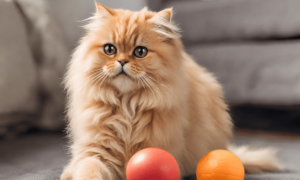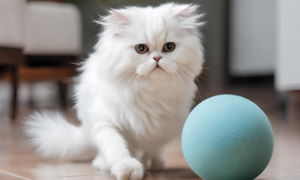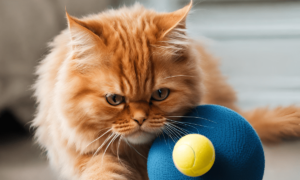The world of feline friendship is wide and varied. Orange Persian cat is one of the most beautiful of these breeds; it is a majestic and charming cat with a unique coat and a personality that can win over cat enthusiasts worldwide.
Because of their gorgeous colour and endearing nature, orange Persian cats have long been adored as valued pets. In this comprehensive article, we explore the world of Orange Persian cats, from their history and physical characteristics to their delightful personalities and appropriate pet-keeping guidelines.
Learn why these gorgeous cats have become popular pets and how to care for them properly.
Origin and History
Orange Persian cats are a lovely variant of the Persian breed, also known as Red Persians, which has its origins in ancient Persia, which is now known as Iran. These cats have a long history of being admired for their beauty and charm.
Breeders have carefully developed the orange-coloured variety throughout the years, creating a distinct and appealing subgroup of Persian cats. For their charming appearance and gentle nature, these felines have been admired across numerous civilizations.
Physical Appearance
Persian cats with orange fur are known for their beautiful, luxuriant fur. Their fur is a bright and eye-catching shade of orange that ranges in intensity from pale cream to deep ginger. Orange Persian cats have a medium to large body size and a strong structure.
Their coats are long, silky, and soft to the touch. They have a broad, rounded head, a flat face, and large, expressive eyes that can be copper, gold, or green. The distinct morphological characteristics of this breed contribute to its enormous popularity and attraction.
Personality and Temperament
Orange Persian cats are valued for their charming personalities and appealing beauty. They have a calm and friendly demeanour, which makes them beloved companions. They have a sweet and affectionate nature. They form strong bonds with their human companions and enjoy being in their presence.
They are gentle, calm, and laid-back, making them ideal pets for families, singles, and seniors alike. Their intelligence and curiosity contribute to their attraction, as they examine their environment with wonder. Despite their relaxed demeanour, they are playful and enjoy interactive toys and engaging activities.
Caring for Orange Persian Cats
1. Brushing
Because of their long and thick hair, they require frequent brushing to prevent mats and tangles. Brushing them daily keeps their coat lustrous and their skin healthy and free of irritation.
2. Nutrition
It is essential to provide a balanced diet for the general health of orange Persian cats. Their dietary demands may differ from those of other breeds; therefore, it’s critical to select high-quality cat food that fulfils their nutritional requirements.
3. Exercise
Orange Persian cats are not the most active cats; frequent exercise is necessary to keep them healthy. Participating in interactive play sessions and offering engaging toys can help prevent obesity and keep kids cognitively engaged.
4. Healthcare
Regular veterinarian check-ups are essential for monitoring their health and addressing any potential difficulties as soon as possible. Vaccinations, parasite management, and dental care are all essential components of their healthcare routine.
Training and Socialization
Orange Persian cats, like other felines, benefit from socialization and training. To teach them basic commands and encourage the desired behaviour, encouraging methods can be used. Early socialization with humans and other pets helps to guarantee that they grow up to be happy, comfortable cats.
Variants of Orange Persian Cats
1. Pale Cream
Pale cream Persian cats have a light, almost pastel orange coat that resembles the soft colours of a peach. Their fur is long, silky, and dense, giving them a luxurious appearance.
Pale cream Persian cats have striking blue or copper eyes, enhancing their overall charm. These cats often exhibit a sweet and affectionate temperament, being gentle and calm companions.
2. Ginger
Ginger Persian cats have a rich, medium-toned orange coat, resembling the colour of ripe apricots. Their fur is velvety, making them incredibly soft to the touch.
Ginger Persians commonly have copper or amber eyes that complement their warm coat colour. Ginger Persians are known for their playful and lively nature. They are curious, and intelligent and enjoy interactive activities.
3. Red-Orange
Red-orange Persian cats have a vibrant and intense orange coat that closely resembles the shade of a ripe pumpkin. Their fur is long, thick, and glossy, giving them an elegant and majestic appearance.
Red-orange Persians often have large, expressive copper or amber eyes, adding depth to their striking appearance. Red-orange Persians are confident, affectionate, and friendly. They enjoy attention and are known for their loving and loyal nature.
4. Deep Rust
Persian cats with deep rust coats have a deep, almost reddish-orange coat that resembles autumn leaves. Their fur is plush, dense, and exceptionally soft, making them incredibly cuddly.
Deep rust Persians commonly have copper or gold eyes that beautifully contrast with their intense coat colour. Deep rust Persians are often calm and observant. They are known for their grace and elegance, making them sophisticated companions.
Each variant of the orange Persian cat has its unique charm, and their varying personalities and coat shades offer a delightful range for cat enthusiasts to appreciate and enjoy.
Common Health Issues in Orange Persian Cats
1. Respiratory Problems
Orange Persian cats suffer respiratory issues due to their flat faces (brachycephalic characteristics). This is referred to as Brachycephalic Airway Syndrome (BAS). Breathing noises, snoring, and difficulties breathing, especially during vigorous activity or in hot conditions. Make sure their living space is well-ventilated, avoid exposing them to high temperatures, and take them to the vet regularly for check-ups.
2. Dental Issues
Orange Persian cats are prone to dental issues such as gingivitis and periodontal disease. Bad smells, trouble chewing, drooling, and irritated gums are all symptoms of gum disease. Brushing their teeth, offering dental treats, and arranging professional dental cleanings with a veterinarian are all part of regular dental care.
3. Polycystic Kidney Disease (PKD)
PKD is a hereditary disorder that causes fluid-filled cysts in the kidneys of Persian cats, notably the Orange Persian cat. Increased thirst, frequent urination, appetite loss, and weight loss are all symptoms. Responsible breeding practices are required since PKD can be genetically tested. Regular veterinarian examinations are recommended for early detection and treatment.
4. Eye Conditions
Orange Persian cats are prone to certain eye conditions like entropion (inward rolling of eyelids) and cherry eye (prolapse of the gland of the third eyelid). Redness, excessive tearing, and visible abnormalities in the eye area Regular eye examinations by a veterinarian In some cases, surgical correction might be necessary.
5. Obesity
Orange Persian cats are prone to becoming overweight, which can lead to a variety of health issues. Increased body weight, difficulty moving, tiredness, and respiratory problems. Controlled food, portion control, frequent exercise via interactive play, and avoidance of excessive snacks are all recommended.
6. Allergies
Allergies are common in Orange Persian cats, which can be provoked by environmental factors or specific foods. Itchy skin, excessive grooming, redness, and hair loss. Identifying and avoiding allergens, using hypoallergenic grooming products, and consulting a vet for appropriate allergy management
7. Urinary Tract Issues
Orange Persian cats are susceptible to urinary tract problems, including kidney stones and urinary infections. Frequent urination, straining to urinate, blood in urine, and urinating outside the litter box. Providing a balanced diet, ensuring access to fresh water, and regular veterinary check-ups for early detection.
Regular veterinary check-ups, a balanced diet, a clean living environment, and prompt attention to any unusual symptoms are crucial in ensuring the overall health and well-being of Orange Persian cats.
Orange Persian Cats Price
The price of an Orange Persian cat depends on a variety of criteria, including the cat’s pedigree, ancestry, age, breeder reputation, and location.
Here are some broad suggestions to help you estimate the possible costs of acquiring an Orange Persian cat.
Breeder Reputation
Reputable breeders may demand higher fees if they follow ethical breeding practices and produce cats with desired features. A Persian cat from a well-known and reputed breeder will cost extra.
Pedigree and Lineage
Persian cats with champion genetics and show-quality pedigrees are frequently more expensive due to their genetic excellence and devotion to breed standards.
Cat Age
Kittens are often more costly than adult cats. Be prepared to pay a premium for a kitten’s youth and ability to be taught and socialized according to your tastes if you decide to adopt one.
Conclusion
Orange Persian cats are the epitome of charm, beauty, and friendship. For good reason, they have earned a particular place in the hearts of cat lovers everywhere. People may give Orange Persian cats a happy, loving existence by learning about their past, valuing their physical characteristics, and nurturing their affectionate nature. Orange Persian cats may be an interesting and rewarding experience, regardless of whether you are an experienced feline lover or are thinking about getting your first cat. Accept the chance to bring these beautiful cats into your house, and start a path full of affection, company, and the pure joy of having a wonderful Orange Persian cat by your side.
FAQs
Q: What makes Orange Persian cats unique among other Persian cat variants?
A: Orange Persian cats are distinguished by their vibrant orange coats, ranging from pale cream to deep rust, giving them a striking and distinctive appearance.
Q: Are Orange Persian cats known for specific personality traits?
A: Yes, Orange Persians are often described as affectionate, playful, and friendly. They are known for their loving nature and enjoy interactive activities with their owners.
Q: Are they indoor or outdoor cats?
A: Orange Persians are best kept indoors to protect their coat and health. If they do go outside, it should be in a secure and supervised environment.
Q: What type of diet is suitable for Orange Persian cats?
A: High-quality cat food, specially formulated for Persians, is recommended. Consult a vet for specific dietary requirements, considering their age, weight, and health status.
Q: Do Orange Persians require specific toys or activities for mental stimulation?
A: Yes, interactive toys and activities that stimulate their minds are beneficial. Puzzle feeders and feather wands can keep them engaged and entertained.




Стильные заметки по подбору модных видов на любой день.
Заметки профессионалов, новости, все показы и шоу.
https://mvmedia.ru/novosti/122-gde-luchshe-pokupat-originalnye-brendovye-veshchi-kak-vybrat-nadezhnye-magaziny-i-platformy/
Стильные советы по выбору превосходных видов на каждый день.
Статьи стилистов, события, все коллекции и мероприятия.
https://luxe-moda.ru/chic/505-7-luchshih-sumok-guess-dlya-pokupki-v-2024-godu-stil-i-funktsionalnost/
Модные советы по выбору отличных образов на каждый день.
Заметки стилистов, новости, все дропы и мероприятия.
https://sofiamoda.ru/style/2024-10-03-principe-di-bologna-roskosh-italyanskogo-stilya-i-elegantnost-na-kazhdyy-den/
Your article helped me a lot, is there any more related content? Thanks!
В нашем магазине вы можете приобрести кроссовки New Balance 574. Эта модель характеризуется комфортом и привлекательным стилем. New Balance 574 подойдут для повседневной носки. Выберите свою пару уже сегодня и почувствуйте разницу легендарного бренда.
https://nb574.sneakero.ru/
На этом сайте доступны оригинальные сумки популярного бренда Bottega Veneta. Здесь доступны для покупки эксклюзивные модели, которые станут изюминкой вашего гардероба. Каждое изделие характеризуется высочайшим качеством, что свойственно бренду Bottega Veneta
https://gorillasocialwork.com/story19525693/bottega-veneta
Thank you for your shening. I am worried that I lack creative ideas. It is your enticle that makes me full of hope. Thank you. But, I have a question, can you help me?
Thanks for sharing. I read many of your blog posts, cool, your blog is very good.
Your article helped me a lot, is there any more related content? Thanks!
Официальный интернет-магазин Bottega Veneta предлагает полный каталог брендовой продукции от легендарного бренда. В нашем каталоге вы сможете найти и приобрести модели актуальных коллекций с удобной доставкой по всей стране.
https://bottega-official.ru